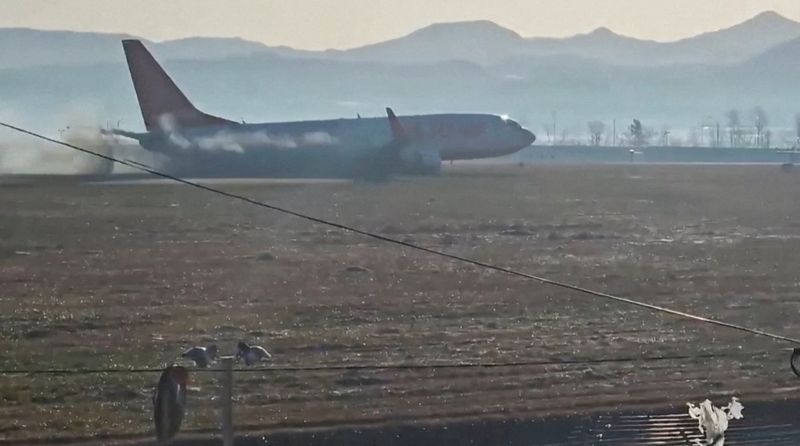By Bart Meijer and Lisa Barrington
(Reuters) -Uncertainty surrounds the deadliest plane crash on South Korean soil, aviation experts said on Sunday. They wondered how much impact a potential bird strike cited by authorities could have had in the downing of the Jeju Air flight.
The apparent absence of landing gear, the timing of the twin-engine Boeing (NYSE:) 737-800’s belly landing at Muan International Airport and reports of a possible bird strike all raised questions that could not yet be answered.
A video broadcast on local media showed the single-aisle plane sliding down the runway without its landing gear deployed before crashing into a wall in an explosion of flames and debris.
“Right now there are many more questions than we have answers. Why was the plane going so fast? Why weren’t the flaps open? Why weren’t the landing gear down?” said Gregory Alegi, an aviation expert and former teacher at the Italian Air Force Academy.
South Korean officials are investigating the crash of Jeju Air Flight 7C2216, including the impact of a possible bird strike and weather. 179 of the 181 people on board died.
Deputy Transport Minister Joo Jong-wan said the runway’s length of 2,800 meters was not a contributing factor and that walls at the ends had been built to industry standards.
A spokesperson for Jeju Air was not immediately available for comment. Jeju Air declined to comment on the cause during news conferences and said an investigation was underway.
Christian Beckert, a flight safety expert and Lufthansa pilot, said the video footage suggested that, apart from the reversers, most of the plane’s braking systems had not activated, causing a “major problem” and a fast landing.
Beckert said it was unlikely that a bird strike would have damaged the landing gear while it was still up, and that if it had happened while it was down, it would have been difficult to raise it again.
“It’s really very rare and very unusual not to lower the gear, because there are independent systems where we can lower the gear with an alternative system,” he said.
The probe should paint a clearer picture, he added.
Under global aviation rules, South Korea will lead a civil investigation and involve the National Transportation Safety Board in the United States, where the plane was made.
Experts say plane crashes are usually caused by a cocktail of factors and it can take months to piece together the sequence of events.
The flight data recorder was found at 11:30 a.m. (02:30 GMT), about two and a half hours after the crash, and the cockpit voice recorder at 2:24 p.m., South Korean officials said.
Australian aviation consultant Trevor Jensen said fire and emergency services would normally be ready for a belly landing, “so this does not appear to be planned”.
CHAIN OF EVENTS
Within minutes, the control tower issued a bird strike warning, pilots called mayday and then attempted to land, officials said, although it was not clear whether the plane had struck birds.
“A bird strike is not unusual, undercarriage problems are not unusual. Bird strikes are much more common, but do not usually cause the loss of an aircraft on their own,” said Geoffrey Thomas, editor of Airline News.
A bird strike could have affected CFM International’s engines if a flock had been sucked into it, but that wouldn’t have disabled them immediately, giving the pilots some time to react, said Australian safety expert Geoffrey Dell (NYSE:) .
After the bird strike warning and Mayday declaration, the pilots attempted to land on the runway from the opposite direction, a Transportation Ministry official said.
That change in plan raised more questions for investigators, said Marco Chan, a senior lecturer in aviation operations at Buckinghamshire New University and a former pilot.
“It was also changed in the opposite direction quite late, which added to the workload,” Chan said. “It’s a lot of guessing games at this stage.”
The captain of the Boeing 737-800 aircraft had served at that rank since 2019 and logged 6,823 flight hours, the South Korean government said. The first officer had served at that rank since 2023 and had logged approximately 1,650 flight hours.
The 737-800 is one of the world’s most flown airliners with an overall strong safety record. It was developed long before the MAX variant was involved in a recent safety crisis at Boeing.

Birds hitting the plane were unlikely to explain the scale of the disaster, Italian aviation expert Alegi said.
“Of course there could have been a bird strike,” he said. “But the consequences are far too great to be the direct cause of the accident.”


